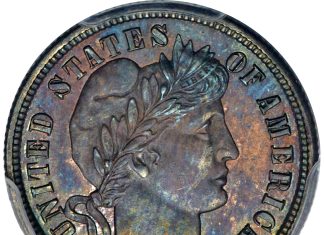A near-Mint State 1796 50C 15 Stars AU58 PCGS, O-101, R.5., will be among the top offerings from Heritage Auctions at its March 17-20 Sacramento Signature® ANA US Coin Auction, held in Hall A of the Sacramento Convention Center.

"The superb condition of this stunning 1796 15 Stars half makes it a truly exceptional coin," said Greg Rohan, President of Heritage Auctions, "one that’ll make a handsome addition to the high-grade type set or a date/variety collection of an advanced numismatist."
An 1863 Three Dollar Gold PR66 Ultra Cameo NGC CAC is the auction’s top gold offering and presents a beautiful and evocative link to America’s Civil War, which severely threatened to disrupt the nascent distribution system for proof coins to a mass numismatic audience.

History records, however, that mintages doggedly persisted through the entire conflict. In 1863, the year that Confederate forces reached Pennsylvania, the same state that houses the Philadelphia Mint, that facility struck a full range of proof copper, silver, and gold coins, including the little-used $3 gold denomination.
The mintage was not high, of course, and today, the proof 1863 $3r gold is a valuable rarity regardless of condition.
"Somewhat over a dozen Proofs survive from a stated production of 39 pieces," wrote Q. David Bowers in The United States $3 Gold Pieces. "Generally, these are in higher grade levels, have cameo contrast, and are very attractive. Such coins are generally available only to buyers who have a great amount of patience.”
Further top offerings include a 1792 1C Washington Roman Head Cent PR64 Brown PCGS, Baker-19, W-10840, R.6, a famous colonial rarity, the exact number of which survive is unknown, although the total is clearly small, given the number of pieces that appear at auction.

A 1796 Quarter Dollar, MS64 NGC, B-2, R.3, the only small eagle issue, another stellar and exceedingly rare early silver offering, produced among the first examples of 25 cent pieces issued in 1796.

Further highlights include, but are not limited to:
- 1915-S $50 Panama-Pacific 50 Dollar Octagonal MS63 PCGS
- 1806 25C MS66 NGC. B-9, R.1, the Eliasberg Specimen, the finest known
- 1794 H10C MS65 PCGS Secure. V-1, LM-1, R.6, the rarest of the four Die marriages known
- 1796 50C 15 Stars AU58 PCGS, O-101, R.5.
- 1793 Chain 1C AMERICA XF40 PCGS. S-3, B-4, Low R.3.
About Heritage Auctions
Heritage Auctions, headed by Steve Ivy, Jim Halperin and Greg Rohan, is the world’s third largest auction house, with annual sales more than $600 million, and 500,000+ registered online bidder members. For more information about Heritage Auctions, and to join and gain access to a complete record of prices realized, along with full-color, enlargeable photos of each lot, please visit HA.com.





